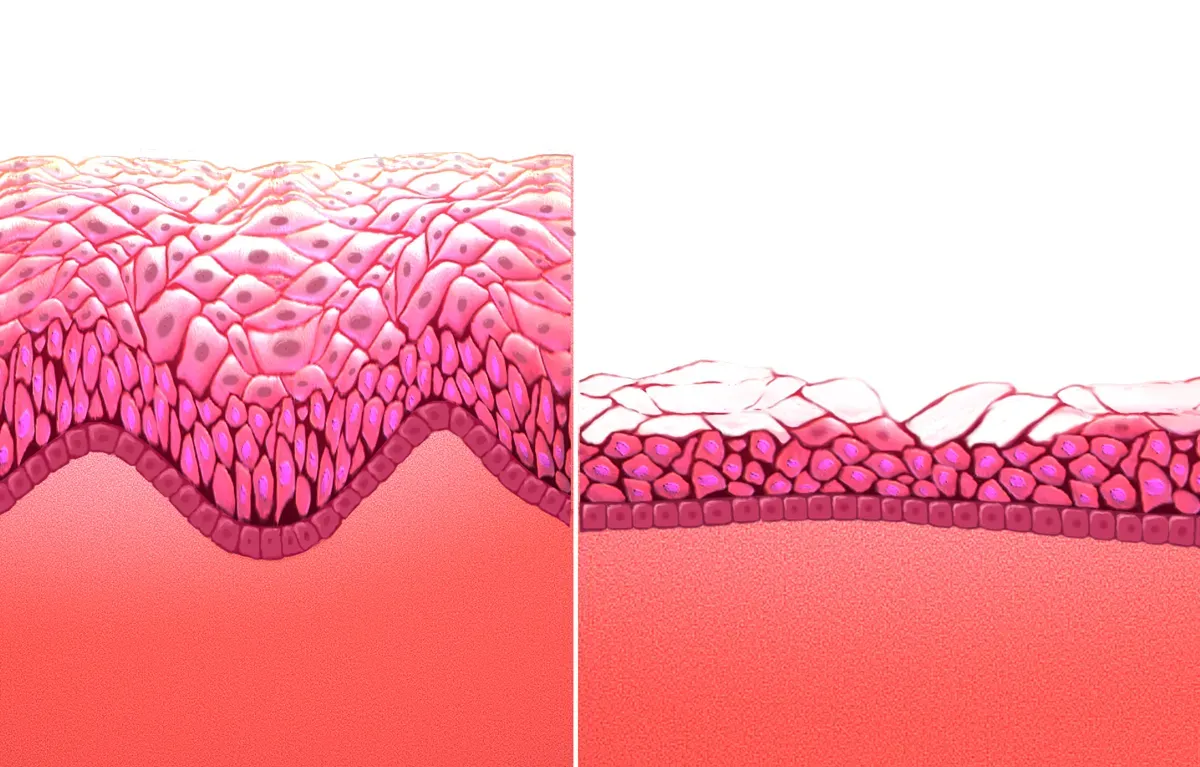


Atrophic vaginitis, or vaginal atrophy, is a condition where there are changes in the “skin,” like the lining of the vagina, most commonly resulting from the loss of estrogen in peri-menopausal and postmenopausal women. Estrogen is responsible for maintaining the thickness, moisture and elasticity of the vagina, as well as maintaining optimal blood flow to the vagina and lower urinary system (bladder and bladder out-flow tube, or urethra).
Estrogen is also responsible for creating and maintaining an acidic environment in the vagina with a pH ranging from 3.5 to 5.0. This acidic environment discourages the growth of potentially harmful bacteria and therefore protects against vaginal and urinary tract infections. Menopause leads to a dramatic loss of estrogen. Medical evidence places this at an approximate 95 percent reduction. This significant drop in your body’s estrogen levels can result in a number of problems in your body. The vaginal tissue becomes thinner and dry resulting in burning, itching, vaginal discomfort and very often painful intercourse. The resulting inflammation also contributes to urinary symptoms such as frequency, urgency, painful urination, incontinence and recurrent urinary tract infections.


If you are experiencing abnormal vaginal discomfort please schedule a consultation with Drs. Pezzella and Rueb today.
Call us at (803) 457-7000 or
Hormone replacement therapy (HRT) can be beneficial in the management of atrophic vaginitis. Atrophic vaginitis is a condition characterized by thinning, drying, and inflammation of the vaginal walls, usually resulting from reduced levels of estrogen in the body.
HRT involves the administration of estrogen, either orally, topically, or through vaginal suppositories, to supplement the body's estrogen levels and alleviate symptoms of atrophic vaginitis. Estrogen helps to restore the health and thickness of the vaginal tissues, improving lubrication and reducing discomfort during sexual intercourse.
HRT can also help with other symptoms associated with atrophic vaginitis, such as itching, burning, urinary frequency, and urgency. By restoring estrogen levels, HRT promotes the growth of healthy vaginal tissue and improves vaginal pH balance, which reduces the risk of infections.
It's important to note that HRT should be prescribed and monitored by a healthcare professional. They will evaluate your individual health history and help determine if HRT is the right treatment option for you. Regular follow-ups are essential to monitor the effectiveness of the therapy and manage any potential side effects.
Atrophic vaginitis is primarily caused by a decrease in estrogen levels, which can occur due to various reasons, including:
Menopause: The most common cause of atrophic vaginitis is menopause. As a woman reaches menopause, her estrogen levels naturally decline, leading to thinning and drying of the vaginal tissues.
Perimenopause: The transitional phase before menopause called perimenopause can also contribute to atrophic vaginitis. During this period, estrogen levels fluctuate, which can result in vaginal changes.
Surgical menopause: Women who have undergone surgical removal of the ovaries (oophorectomy) may experience a sudden decline in estrogen levels, which can lead to atrophic vaginitis.
Breastfeeding: Estrogen levels can decrease during breastfeeding, resulting in vaginal dryness and atrophy.
Cancer treatments: Radiation therapy or chemotherapy for cancer, particularly in the pelvic area, can disrupt estrogen production and cause atrophic vaginitis.
Other factors, such as certain medications, hormonal imbalances, and immune system disorders, may also contribute to the development of atrophic vaginitis.
The symptoms of atrophic vaginitis can vary from person to person but commonly include:
While it may not be possible to completely prevent atrophic vaginitis, there are steps you can take to reduce the risk or delay its onset:
The time it takes to see improvements with treatment for atrophic vaginitis can vary from person to person. Some individuals may experience relief from symptoms within a few weeks of starting treatment, while others may take several months. It is important to follow the treatment plan and have regular follow-up appointments to monitor progress and make any necessary adjustments. Patience and consistency with treatment are key.
Yes, atrophic vaginitis can definitely affect sexual intercourse. The thinning, drying, and inflammation of the vaginal tissues can cause discomfort, pain, and even potential injury during sexual activity. Vaginal dryness may make penetration uncomfortable or painful, leading to a decrease in sexual desire or avoidance of intercourse altogether. Additionally, friction during intercourse can further irritate the delicate vaginal tissues, causing additional discomfort or even mild bleeding.
Yes, atrophic vaginitis can increase the risk of developing vaginal infections. The thinning of vaginal tissues and reduction in natural lubrication can disrupt the normal protective barriers of the vagina, making it more susceptible to infections. The decrease in estrogen levels can alter the vaginal pH balance, creating an environment that is more favorable for the growth of harmful bacteria or fungi.
Common vaginal infections that may be more likely to occur in individuals with atrophic vaginitis include bacterial vaginosis, yeast infections (such as candidiasis), and urinary tract infections (UTIs). These infections can cause symptoms such as itching, abnormal discharge, odor, burning sensation, and frequent urination.
